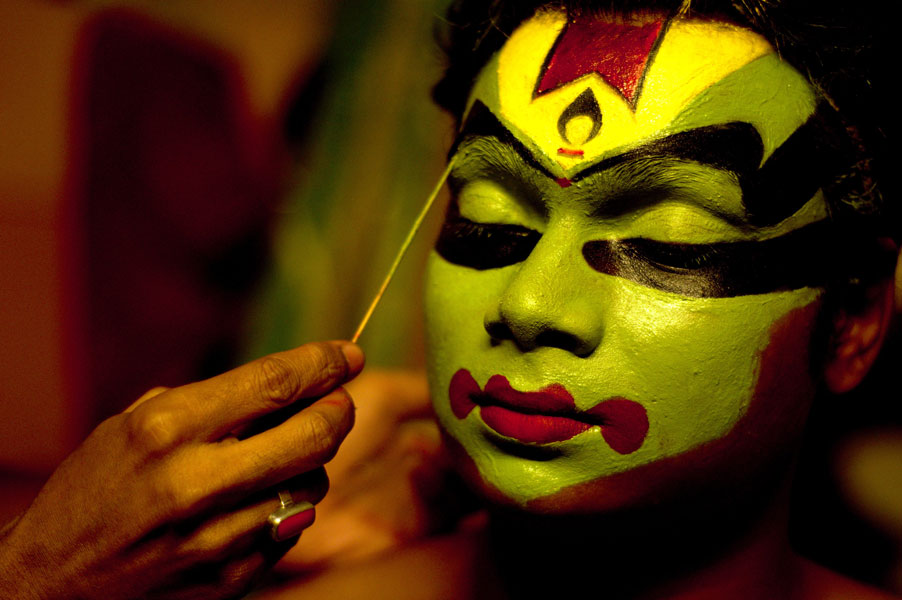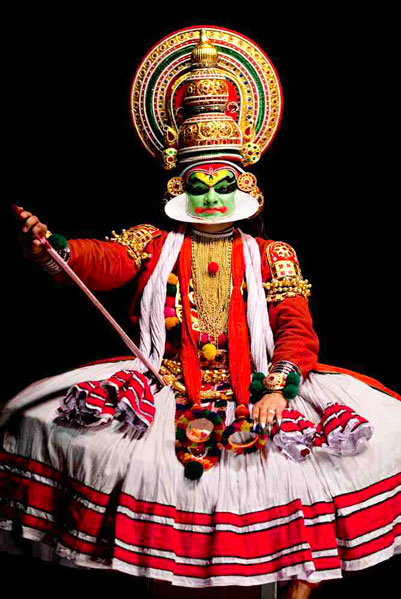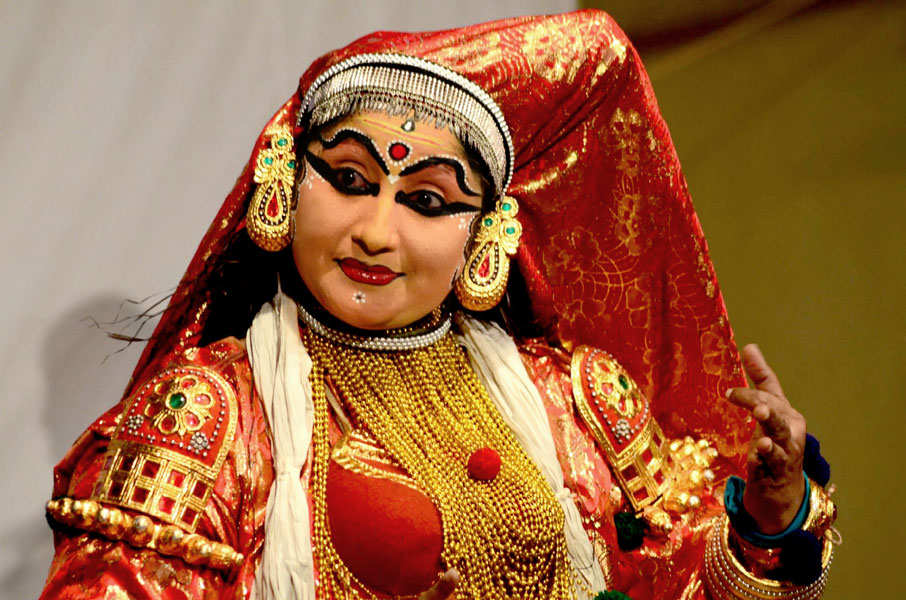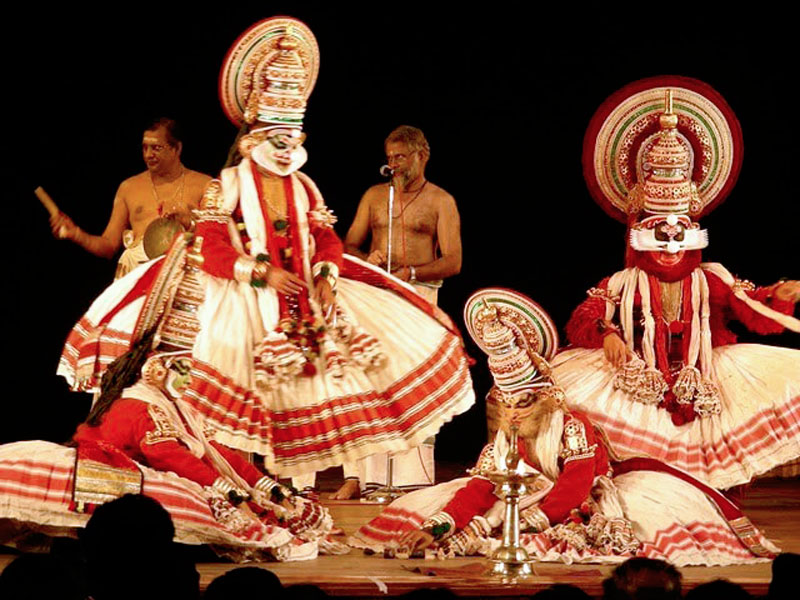Kathakali – Dance Drama
Kathakali is probably the most fascinating traditional performing art form in India’s rich cultural pageant… this uniquely interpretative dance is governed by dramatic dynamics, including an elaborately defined code of body kinetics, which combines with beautifully
eloquent gestural representation.
— K Ayyappa Panicker, noted Malayalam poet
The intrinsic beauty of every classical dance form of India is rooted in the myriad ways that a story can be communicated through dance. Each style has its own distinctive characteristics, though all of them are structured on the grammar of Bharatha’s dance treatise, Natya Shastra.
In Kathakali, the sheer flamboyance and intensity of the exposition provide a larger-than-life magnitude. The dance form originated in Kerala and was traditionally performed in theatres unlike most other Indian classical dances which were performed inside Hindu temples. It was performed exclusively by male dancers and incorporated movements from the ancient athletic and martial art traditions of South India. It appeals to the senses through an aesthetic synthesis of music, dance, drama and literature, and is easily distinguished by the dramatic make-up, elaborate costumes and colourful face masks that the dancers adorn.
Kathakali which literally means story (katha) and dance (kali), evolved as a full-fledged classical art form only in the 17th century but it dates back to ancient folk arts like Koodiyattam which were in existence in the 1st millennium CE. Koodiyattam, or Kuttiyattam as it is also known, is a traditional performing art form which is a combination of ancient Sanskrit theatre with elements of Koothu, a folk that dates back to the Sangam era and is officially recognised by UNESCO as a ‘Masterpiece of the Oral and Intangible Heritage of Humanity’.
Kathakali is an operatic dance where a story is artfully dramatised and performed from dusk to dawn with periodic interludes for the performers and audience. Earlier plays used to last for several nights but in recent times, performances have been drastically shortened. The dance is based on plays called Attakatha which are derived from the Ramayana, Mahabharata and the Bhagavatha Puranas. The Attakatha (enacted story) is written in Sanskritised Malayalam in a format that helps identify the action and dialogue in a performance. Kathakali used to be performed on open ground outside temples until special theatres called Kuttampalam were constructed inside the temple compound to facilitate performances. The stage is mostly bare and lit with a Kalivilakku (lamp of dance) that was in use from the days of Kuttiyattam. The lamp provided light through the night before the discovery of electricity and the tradition is continued even today to highlight the facial expressions and emotions of the dancers.
Kathakali is easily recognised by its Aharya, consisting of elaborate costumes, head dresses, face masks and vividly painted faces. The facial make-up is elaborate and complex and takes about four hours to wear and two hours to remove. The artist who guides this make-up known as Chouttikkaran, is an important person both at the training and also the performing stage. The dancer lies on his back on the floor while the expert paints his face. The make-up follows a prescribed guideline that helps the audience identify the characters like gods, demons, saints and animals. Certain colours are associated with particular moods and sentiments. Normally, light green represents sringara or love, red for raudra or anger, and yellow is for adhbuta or wonderment. Kathakali follows these basic colour patterns to transform the actor into the character which he is playing.
Mrinalini Sarabhai is reputed to be the first female dancer who popularised Kathakali by performing extensively in India and abroad.
Seven basic make-up types are used with the predominant colours made from rice paste and vegetable colours that are applied on the face. Pachcha (green) with lips painted brilliant coral red portrays noble characters like Krishna, Vishnu, Shiva, Rama, Arjun and Surya. The jawbone is exaggerated by pasting cut-outs either of papier-mache to give the face enlarged dimensions. Tati (red) is used to depict evil characters like Ravana, Dushasana and Hiranyakashipu. Kari (black) is used for forest dwellers, hunters and middle ground characters. Demonesses and treacherous characters are also painted black but with streaks or patches of red. The upturned moustache is common and a white blob of pith is attached to the nose which makes the characters seem more fantastic than human. This make-up is called Kathi. Demonic characters also wear a pair of large canine teeth protruding out of the corners of their mouth. Yellow is the code for monks, mendicants and women. Minukka (radiant, shining) with a warm yellow, orange or saffron is used to depict noble, virtuous feminine characters like Sita, Draupadi or Mohini. Men who act the roles of women also add a false top knot to their left and decorate it in a style common to the region. Antiheroes, villains, demons and some special characters in conventional Kathakali don the Tadis (beard). The red beard is for evil characters; black beard is used for offbeat characters and white beard represents a divine being, someone with virtuous inner state and consciousness like Hanuman. Teppu is for special characters such as Garuda, Jatayu and Hamsa who act as messengers in Hindu mythologies. Face masks and head gear is added to accentuate the nature of the characters. The costume and make-up transform the actor from his human proportions to superhuman stature.
The fine art of Kathakali survived through a gurukul system and passed down through generations till the turn of the 20th century when it faced near extinction like all other classical arts of India. In 1927, renowned poet Vallathol Narayana Menon and Mukunda Raja established the Kerala Kalamandalam to revitalise the art form. In 1933, the Maharaja of Cochin donated a piece of land and a building in Cheruthuruthy village to be developed into an institute of excellence. It has been functioning as a grant-in-aid institution under the Cultural Affairs Department of the Kerala government and was accorded the status of ‘Deemed University for Art and Culture’ by the Government of India in 2007. Kalamandalam has trained some of the finest Kathakali dancers including Ramankutty Nair, Krishna Prasad, Vasu Pisharody, Kesavan Namboothiri and Kavungal Chathunni Panicker.
Traditionally, Kathakali was a male art form where men also performed the roles of women characters in what was known as Stree Vesham. The training was often strenuous and required a high level of physical fitness. Body massage borrowed from martial arts tradition became an essential aspect of Kathakali training to make the body supple for vigourous dance movements. Women entering this predominant male bastion was considered a transgression for many years. The first documented woman to participate in a Kathakali dance drama was Kartyayini from Tripunithura and the temple town now has an all-women Kathakali troupe. Mrinalini Sarabhai is reputed to be the first female dancer who popularised Kathakali extensively in India and abroad. She was a student of Guru Thakazhi Kunchu Kurup and trained many dancers in Kathakali at the Darpana Academy of Performing Arts which she established in Ahmedabad in 1949. Dr Kanak Rele also broke stereotypes to learn Kathakali from Guru ‘Panchali’ Panicker at seven. But Kathakali dancer Sasikala laments that it is very difficult for women to perform even today. She says, “I hail from an orthodox family and my grandparents were against my entering a world of men. Only my father supported my decision. He told me that if I have a grip on my shoes I can go anywhere. I faced many challenges but worked very hard to prove that I am as capable as any man and now I want to show that I can do better.”

Kathakali is steeped in tradition but dancers are trying to break new ground by experimenting with stories from other cultures to have a wider reach. Sadanam Balakrishnan successfully presented Hela, a recreation of the Greek tragedy by Euripides, and also Shakespeare’s Othello and Corneille’s Le Cid in traditional Kathakali style. Interestingly, many similarities can be found between Kathakali and the Japanese theatre, Noh. In both styles men traditionally performed all the roles including those of women. Emotions are primarily conveyed by stylised gestures while the costumes communicate the nature of the characters. Both styles use elaborate masks, costumes, make-up and props to communicate larger-than-life stories through a magnificent dance style. As Arundhati Roy sums it up in The God of Small Things, “It didn’t matter that the story had begun, because Kathakali discovered long ago that the secret of the Great Stories is that they have no secrets. The Great Stories are the ones you have heard and want to hear again. The ones you can enter anywhere and inhabit comfortably. They don’t deceive you with thrills and trick endings.”



